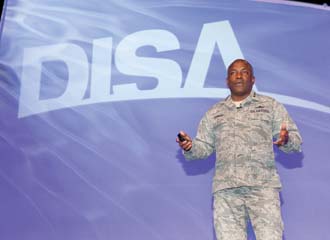Budgets, Security Mean Big Changes
 |
Lt. Gen. Ronnie D. Hawkins, USAF, director of the Defense Information Systems Agency (DISA), addresses the audience at the 2012 DISA Mission Partner Conference in Tampa, Florida, in May. |
Cloud, mobility and consolidation are growing in importance within the military information technology community and for its private-industry partners. Lt. Gen. Ronnie D. Hawkins, USAF, director, Defense Information Systems Agency, spoke about his organization’s efforts in those areas such as a major project migrating defense network users to an enterprise email system. In 18 months, 390,000 U.S. Army personnel have made the transition. Approximately 7,000 U.S. Air Force personnel have migrated in the last few months as well, and the service will begin a larger project next year. Also in line to transition are the Joint Staff and the Defense Logistics Agency.
Gen. Hawkins made his remarks during the 2012 Defense Information Systems Agency (DISA) Mission Partner Conference in Tampa, Florida, in May. Dr. Edward Amoroso, the chief security officer at AT&T, spoke of the necessity of moving to a cloud to keep information secure. He said because of all the exceptions and connections used in networks, perimeter security is really no security at all. Cloud storage presents more opportunities for real protection, and owners can put their data in various clouds with different security levels.
Mark Hurd, president of Oracle Corporation, said his company has moved all of its applications to a cloud environment, conducting $1 billion worth of revenue there. In the future, Hurd expects to see clouds behind firewalls. Reduced budgets will drive the government toward cloud as it cannot afford to invest in or maintain multiple infrastructures. “Cloud is going to happen,” Hurd stated. “It’s an economic necessity.”
Jeff Barr, the senior web services evangelist, Amazon Web Services, described how Amazon uses cloud to remain within its tight profit margins. The company actually has dropped prices 17 times because of savings realized through cloud computing.
Gen. Keith Alexander, USA, also discussed cybersecurity and how mobility is making it a harder challenge. The general is the commander of U.S. Cyber Command, director of the National Security Agency and chief of the Central Security Service. He stated that industry efforts to secure mobile devices are making a difference within the U.S. Defense Department. Gen. Alexander is interested in “bring your own device” (BYOD) policies but has concerns about how to secure information properly.
Debate among members of the military chief information officer (CIO) community regarding BYOD is ongoing. Rear Adm. Diane Webber, USN, director, communications and networks division of the U.S. Navy, said that she firmly believes the military must go mobile and people will want to use their own devices.
But Brig. Gen. Kevin Nally, USMC, director, command, control, communications and computers/CIO of the Marine Corps, does not support BYOD initiatives. He cited recent examples of U.S. troops filming their own deplorable behaviors and posting the recordings on social networking websites as a consequence of the open-device policies. And with upcoming massive budget cuts, he does not want to invest money in BYOD up front. Nor have any senior Marines told him that they need to be able to use a new mobile device to complete their missions.
Michael Krieger, the deputy CIO/G-6 of the U.S. Army, supported BYOD in his remarks and believes significant increases in work force productivity could result from minuscule investments. Terry Halvorsen, CIO of the Navy, said it will come down to where it makes sense to invest. However, Halvorsen added that as soon as a business case is made for BYOD, “I’ll be the first one to sign up.”
The military services are conducting more than 50 BYOD pilots. Teri Takai, CIO of the Defense Department, said her concern is that they will turn into 50 operational programs she will have to stitch together.
Additional coverage of the speakers and panels at the DISA Mission Partner Conference is available at http://bit.ly.signaldisa2012




Comments